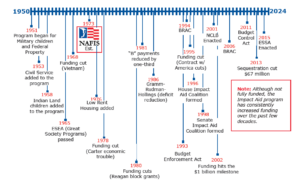Impact Aid History
A Brief History of Impact Aid
The Impact Aid Program, signed into law by President Harry Truman in 1950, is the nation’s oldest K-12 Federal education program. Nationwide, approximately 1,100 school districts enrolling nearly 8 million students benefit from Impact Aid funding.
Today’s Impact Aid program had its beginnings in the early 1800s. Regulations passed in 1821 supported the cost for schools to educate military-dependent children. Then, the Johnson O’Malley Act of 1934 identified that there were no local taxes to educate Native American children and provided funding for them. This Act was the first acknowledgement by the Federal Government of its obligation to the local school district for educating children residing on Indian Lands. Additional pieces of legislation passed in the late 1930s and early 1940s were the precursor to the modern day Impact Aid program.
Impact Aid, originally PL 81-874, was incorporated into the Elementary and Secondary Education Act in 1994. It’s now Title VII of the Every Student Succeeds Act (ESSA). Funding for the program is approved annually by Congress through the Labor, Health and Human Services, Education Appropriations Subcommittee bill, and the program is administered by the U.S. Department of Education. The program reimburses school districts for the loss of local tax revenue due to the presence of the Federal Government. Federal activities reduce local taxes because Federal property is removed from the tax roll and/or the school district is educating students with no or reduced tax revenue associated with them. Lost tax revenue includes residential taxes, property taxes from business or industry, sales taxes, income taxes and local licenses and fees.

Take Action
Learn more about your Federal representatives & participate in the latest NAFIS advocacy campaigns & surveys through the NAFIS Action Network.